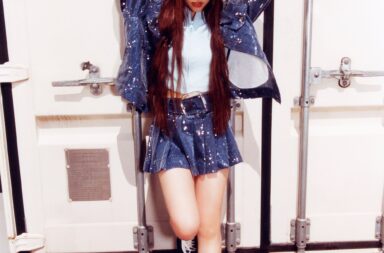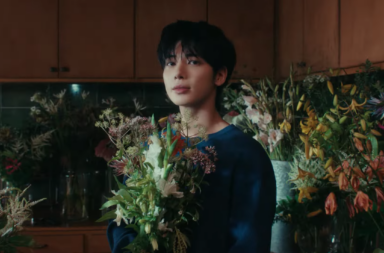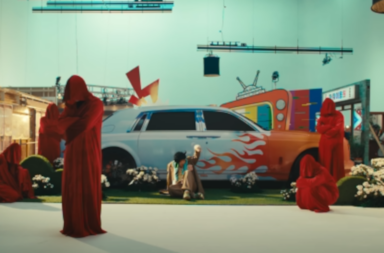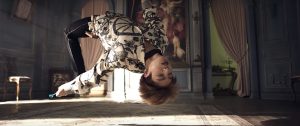 BTS has made their glorious comeback, which means the brain powers of fans and casual followers alike are, once again, put to the test. It’s a good thing this fandom is so darn huge, because how else are we supposed to make sense of anything?
BTS has made their glorious comeback, which means the brain powers of fans and casual followers alike are, once again, put to the test. It’s a good thing this fandom is so darn huge, because how else are we supposed to make sense of anything?
There are at least two things we know for sure: this comeback extends the theme of growth from “The Most Beautiful Moment in Life” cycle, and is centred around the idea of “boy meets evil”. The growth theme is established through the subtle motif of child’s play: Suga rides a small bicycle into the museum and smacks an unsuspecting Jimin on the head, Jimin holds a slingshot, and Jungkook hangs from a swing and eats a lollipop.
The most apparent version of this motif is Jin‘s balloon, and the scene in which he lets go of it points clearly to the idea of growing up. The other instances morph as well to indicate maturity. Jimin’s slingshot finds its grown-up counterpart in J-Hope‘s bow and arrow. Swinging creates an experience that resembles flying, and the image of Jungkook on the swing transforms into an image of flight as he floats mid-air, surrounded by feathers.
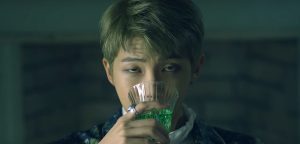 The way Jungkook leans back in both shots are evocative of Icarus’s fall, a reference which makes the metaphor of flight an ambivalent one. The myth is about the bold pursuit of ambition, but it is also about the dangers of greed, of giving in to the lures of ambition. Temptation comes in several other forms: Jimin’s apple is a Biblical reference to sin in general, while the smoke in Rap Monster‘s scenes liken the setting to an opium den, and the liquid he sips resembles absinthe, a representation of the lure of alcohol and drinking. It is interesting to note that the struggle with evil is not external, but internal, relating to one’s own inclination towards temptation.
The way Jungkook leans back in both shots are evocative of Icarus’s fall, a reference which makes the metaphor of flight an ambivalent one. The myth is about the bold pursuit of ambition, but it is also about the dangers of greed, of giving in to the lures of ambition. Temptation comes in several other forms: Jimin’s apple is a Biblical reference to sin in general, while the smoke in Rap Monster‘s scenes liken the setting to an opium den, and the liquid he sips resembles absinthe, a representation of the lure of alcohol and drinking. It is interesting to note that the struggle with evil is not external, but internal, relating to one’s own inclination towards temptation.
But this still leaves a whole bunch of questions. How does this idea of boy meets evil tie in with the title of the track, “Blood Sweat & Tears”? How is the MV connected to the short films? What do we do with all the literary, philosophical, and artistic allusions—Herman Hesse’s Demian, Abraxas, the paintings, the Friedrich Nietzsche quote, the sculptures? What’s with the neon colours that contrast so jarringly with the dreamy, mock-Victorian aesthetic? And the million-dollar question: why does Jin kiss the statue?
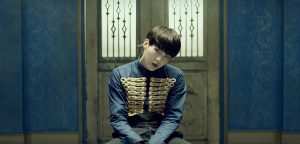 The reading I am about to propose is that the “Blood Sweat & Tears” MV is not just about any boy meeting evil, but about a boy being exposed to the idea of evil through art, and further, facing evil as a young artist. In other words, it is not just a tale of growth, but a Künstlerroman—the coming-of-age of an artist. This is not the only way of interpreting the MV, but it is an angle that best answers the questions I have raised. It is also an approach with powerful, evocative implications for the group’s aspirations as artists.
The reading I am about to propose is that the “Blood Sweat & Tears” MV is not just about any boy meeting evil, but about a boy being exposed to the idea of evil through art, and further, facing evil as a young artist. In other words, it is not just a tale of growth, but a Künstlerroman—the coming-of-age of an artist. This is not the only way of interpreting the MV, but it is an angle that best answers the questions I have raised. It is also an approach with powerful, evocative implications for the group’s aspirations as artists.
The “Wings” short films portray a range of high and low art forms: paintings (the black bird, the forest, the mother cradling her child), dance (“Lie” and “Mama”), music (Suga’s piano-playing in “First Love”), photography (Jin’s polaroids in “Awake”), tattooing (“Reflection”), and graffiti (“Stigma”). Most of these instances also portray the members as artist figures.
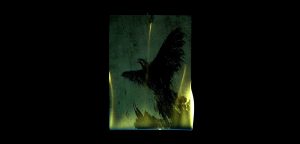 Art is likewise foregrounded in the MV through the museum setting, and the use of paintings: The Fall of the Rebel Angels that captivates Jin, The Lament for Icarus in the shots of Jungkook on a swing, and Landscape with the Fall of Icarus in front of the balcony that V jumps from.
Art is likewise foregrounded in the MV through the museum setting, and the use of paintings: The Fall of the Rebel Angels that captivates Jin, The Lament for Icarus in the shots of Jungkook on a swing, and Landscape with the Fall of Icarus in front of the balcony that V jumps from.
The title, “Blood Sweat & Tears”, is a more artistic take on the idea of the sacrifices BTS has had to make for their career, which they have highlighted in earlier tracks like “Dope”. The lyrics are couched in the rhetoric of complete submission to the temptations of a passionate, dangerous love affair:
Kiss me on the lips lips
A secret between just the two of us
I’m deeply addicted to the prison that is you
I can’t serve anyone else that isn’t you
This can be read as a metaphor for the boys trading in their “blood, sweat and tears” and their “body, mind, soul” for their art.
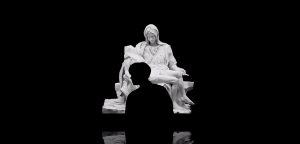 The idea that the artistic life is fraught with struggles is emphasised in the short films. There are hints of constraints that artists have to face or break away from: V is arrested for graffiti and vandalism, possibly alluding to the control of social forces over artists. Suga trespasses by smashing a glass door; the breaking of this physical structure could be read as the struggle to overcome existing artistic, social, or political trappings. The struggle to break away from constraints is reinforced by the animalistic scratches on Jin’s door. Rap Monster is kept away from means of communication by the chains around the telephone booth, perhaps gesturing towards the isolated state artists often find themselves in. J-Hope is kept locked up in a room and has to take pills, hinting at psychological issues.
The idea that the artistic life is fraught with struggles is emphasised in the short films. There are hints of constraints that artists have to face or break away from: V is arrested for graffiti and vandalism, possibly alluding to the control of social forces over artists. Suga trespasses by smashing a glass door; the breaking of this physical structure could be read as the struggle to overcome existing artistic, social, or political trappings. The struggle to break away from constraints is reinforced by the animalistic scratches on Jin’s door. Rap Monster is kept away from means of communication by the chains around the telephone booth, perhaps gesturing towards the isolated state artists often find themselves in. J-Hope is kept locked up in a room and has to take pills, hinting at psychological issues.
Art is also often associated with violence and suffering: in “Begin”, Jungkook has a nightmare of a car crash and glass shattering over the painting of the black bird, and Suga’s piano in “First Love” goes up in flames. In “Blood Sweat & Tears”, J-Hope shoots an arrow at V that produces a colourful splatter, and coloured water bursts into the air around J-Hope. The Fall of the Rebel Angels depicts a mass of creatures tangled in combat, their faces twisted in horror, while The Lament for Icarus depicts grief and death.
I n short, to be an artist is to face, embrace, and grapple with the dark things in life and the evils of the world. This message is suggested by the quote above the mirror that Jin walks towards:
n short, to be an artist is to face, embrace, and grapple with the dark things in life and the evils of the world. This message is suggested by the quote above the mirror that Jin walks towards:
“Man muss noch Chaos in sich haben, um einen tanzenden Stern gebären zu können. [You must have chaos within you to bear a dancing star.]”
This is taken from German philosopher Friedrich Nietzsche’s Thus Spoke Zarathustra. The image of birthing a dancing star can be read as a metaphor for artistic creation and beauty. In the same work, Nietzsche discusses the concept of the Übermensch (overman), a person who is able to embrace both the good and the bad in life, influence the thoughts of others creatively, and who is willing to risk all for the sake of enhancement of humanity. The prominence of art and the artist figure in the MV suggests that the overman here is the artist, and the Nietzsche quote can be seen as the artist’s manifesto.
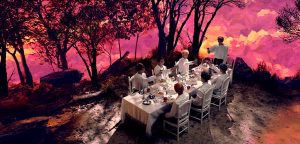 The idea that the artist’s sacrifice brings about greater good for people is reinforced by two references to the Crucifixion. The first is the statue behind J-Hope, a replica of Michelangelo’s Pietà which depicts the body of Jesus on the lap of his mother Mary after the Crucifixion. It has been secularised—in the shot in which the statue’s face explodes, we can see that the torso up of the body being carried depicts not Jesus but an anonymous figure made in a geometric sculptural style. The second reference is the scene in which Jin leads the members in a toast, which has strong echoes of the Last Supper, the final meal that Jesus shared with his disciples before the Crucifixion. These details underscore the notion of a person who sacrifices himself to save humanity.
The idea that the artist’s sacrifice brings about greater good for people is reinforced by two references to the Crucifixion. The first is the statue behind J-Hope, a replica of Michelangelo’s Pietà which depicts the body of Jesus on the lap of his mother Mary after the Crucifixion. It has been secularised—in the shot in which the statue’s face explodes, we can see that the torso up of the body being carried depicts not Jesus but an anonymous figure made in a geometric sculptural style. The second reference is the scene in which Jin leads the members in a toast, which has strong echoes of the Last Supper, the final meal that Jesus shared with his disciples before the Crucifixion. These details underscore the notion of a person who sacrifices himself to save humanity.
The choice of Abraxas as a motif ties in with the figure of the overman: as an ambivalent figure who has been variously portrayed as a god and a demon, Abraxas, like the overman, unites the opposites of good and evil. The artist, likewise, has to embrace chaos in order to produce good and beauty in the form of art.
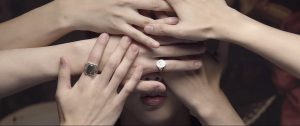 The dance incorporates gestures of the members covering their eyes, ears, and mouths, recalling the three wise monkeys that embody the proverbial principle of “see no evil, hear no evil, speak no evil”. Instead of trying to ignore evil, however, the boys start to open their senses to it. This is shown most distinctly in the shot of the members removing their hands that were shielding Jin’s face. Going back to the idea of the Künstlerroman, accepting the presence of evil in life is a crucial part of the formation of an artist.
The dance incorporates gestures of the members covering their eyes, ears, and mouths, recalling the three wise monkeys that embody the proverbial principle of “see no evil, hear no evil, speak no evil”. Instead of trying to ignore evil, however, the boys start to open their senses to it. This is shown most distinctly in the shot of the members removing their hands that were shielding Jin’s face. Going back to the idea of the Künstlerroman, accepting the presence of evil in life is a crucial part of the formation of an artist.
Jin’s kissing of the statue, in presenting a unity between him and art, could be symbolic of the moment in which the boy who meets art becomes an artist. This may be why the MV erupts into colourful disarray after the kiss: pink and green water shoots up around J-Hope, the winged statue cracks and paint leaks out, and the dance sequence segues into negative colours of white and magenta. It is a visual representation of the embracing of the artistic endeavour and its accompanying chaos.
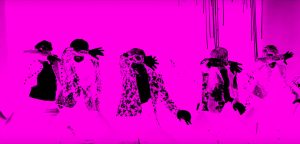 It should be noted, though, that the segues into a neon, pop art aesthetic begin before the kiss. An alternative reason for the contrast between this and the mock-Victorian aesthetic could be that although the MV invokes classical and Victorian art, it is still decidedly contemporary. Hence, the postmodern mixing of styles and art forms, high art and popular culture, is a reminder of its modernity.
It should be noted, though, that the segues into a neon, pop art aesthetic begin before the kiss. An alternative reason for the contrast between this and the mock-Victorian aesthetic could be that although the MV invokes classical and Victorian art, it is still decidedly contemporary. Hence, the postmodern mixing of styles and art forms, high art and popular culture, is a reminder of its modernity.
Another interesting detail is the two statues breaking after the kiss: the winged statue cracks, and the face of the Pietà statue ruptures. I chanced upon Nietzsche’s principles of the Apollonian and the Dionysian, which may not have been something the creative team had in mind, but is nevertheless fascinating to think about. The Apollonian relates to rationality, form, and structure, and sculpture is the most Apollonian of the arts since it relies entirely on form for its effect.
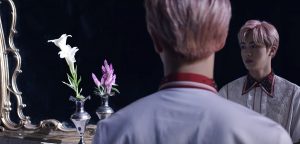 Conversely, the Dionysian is that which opposes rationality and breaks down structure. Music is the most Dionysian of the arts, since it appeals directly to man’s instinctive, chaotic emotions and not to his formally reasoning mind. The coming-of-age in “Blood Sweat & Tears” is then not just one of an artist, but specifically a musician, which of course the boys of BTS are.
Conversely, the Dionysian is that which opposes rationality and breaks down structure. Music is the most Dionysian of the arts, since it appeals directly to man’s instinctive, chaotic emotions and not to his formally reasoning mind. The coming-of-age in “Blood Sweat & Tears” is then not just one of an artist, but specifically a musician, which of course the boys of BTS are.
Embracing the darkness in life may seem to make the artist more vulnerable, but the final sequence of Jin looking in the mirror suggests otherwise. While the vase contains delicate, fragile-looking white flowers, its reflection is a bunch of Gayfeathers, also known as Blazing Star, a flower known to be tolerant of disease and inclement weather. There is a paradoxical suggestion that accepting chaos makes the artist stronger at the same time that it puts him at risk.
Like how Jimin’s face parallels the winged statue with its streaks of paint tears, Jin’s face cracks just like the statue’s. They become mid-way between human and art, symbolic of how the body of the artist is where art is created, with the tears and cracks as a reminder of the artistic struggle.
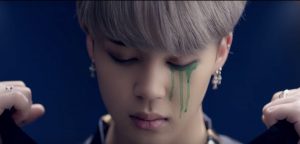 Much as I love this Künstlerroman angle, however, I can’t say that the MV is without its share of issues. There is a sense of disconnection between the narration sequence and the other sequences. Also, by pulling from so many literary, philosophical, and artistic sources, the MV toes the line between coherence and incoherence. In addition, it runs the risk of excluding those who are unable to pick out the references, and the meaning can remain inaccessible.
Much as I love this Künstlerroman angle, however, I can’t say that the MV is without its share of issues. There is a sense of disconnection between the narration sequence and the other sequences. Also, by pulling from so many literary, philosophical, and artistic sources, the MV toes the line between coherence and incoherence. In addition, it runs the risk of excluding those who are unable to pick out the references, and the meaning can remain inaccessible.
Still, this artistic decision is an act of trust: by weaving in a myriad of allusions, BTS and their creative team are creating a challenge that shows implicit faith that their fans and viewers can figure out what’s going on. And the magic of it is that there won’t just be one neat explanation; instead, it spawns interpretation after interpretation. Great art never lent itself to limited readings or let the person encountering it stop simply at appreciation. It draws the viewer into the creative process itself, to puzzle over it and continue to make meaning long after it has been passed on from the hands of the artist.
MV Rating: 4.7/5
(YouTube, BTS-Trans, Images via Big Hit Entertainment, Ilgan Sports, “Liatris spicata (Gayfeather)”, “Nietzsche, Dionysus and Apollo”, “Nietzsche’s idea of an overman”, “Pietà by Michelangelo”)
Note of acknowledgement: I was just about as clueless as anyone at first, but was able to develop this reading thanks to some ideas and comments I came across. I am greatly indebted to sekai-31‘s suggestion of the link between art and the Nietzsche quote, and Is-this-real‘s mention of Nietzsche’s idea of the Übermensch.
Other minor details I adapted include YouTube user Leila Soriano’s remark on the “see no evil, hear no evil, speak no evil” reference, kimnumbers’s comment on the liquid Rap Monster appears to be drinking, and Roshi’s post on the purple flower.
